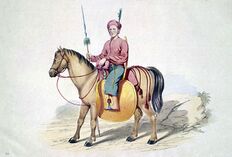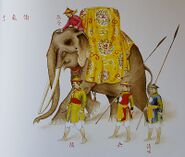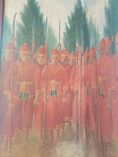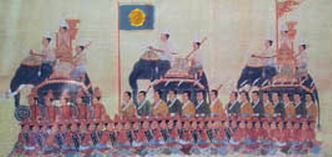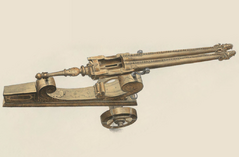Transition from Jiao to Toki
The transition from Jiao to Toki, Jiao–Toki transition, or the Toki unification of Xiaodong saw the transition between two major Xiaodongese dynasties from 1659 to 1694. After the Red Orchid Rebellion toppled the Jiao dynasty, a power vacuum emerged in Xiaodong. The west saw the Red Orchid rebels divided between the Zhao and Wei dynasties, and other minor factions, while the Togoti Khaganate invaded from the northern borders. In the east the Jiao regrouped in Rongzhou, but were surprised by an invasion by the Khaunban Empire and became divided between multiple emperors and factions. Toki Sinzou, originally a Jiao retainer, organised an ambitious campaign led by other Senrian mercenaries, and declared the Toki dynasty in 1664. This period ended with the rise of the Toki, the fall of the Jiao, collapse of the Khaunban and Togoti empires, and suppression of other minor factions in the Toki's unification of Xiaodong.
Overview
Red Orchid Rebellion
Situation of the late Jiao dynasty
Khaunban invasion
Four emperors
Jiao-Toki alliance
Shenkong
Toki conquest of the Zhao dynasty
Yosioki's Wei campaign
Toki Sinzou and formation of the Toki dynasty
Five righteous clans
Jiao defectors and Red Orchid rebels
Khaunban expansion
Intharatcha's Grand Army
The creation of the Khaunban Empire had primarily been through military means, and lacking longevity or legitimacy outside of its constituent rulers' personal ties to Intharatcha, required a strong military to remain consolidated. At the start of Intharatcha's reign his army was largely composed of Kasi peasant levies, supported by cavalry, largely from the nobility, and a small elephant corps. It was with this army that Intharatcha was able to overthrow Sippommese rule of Khaunban and establish Khaunban as the new power in the Lueng river valley. This small nucleus would form the basis of the later ' Grand Army' (kongthap thiyingyai)
As the empire expanded so did the diversity within the army. The majority of the levies remained ethnically Kasi, but they were joined by Namkwonese, Svai, Kyin, and Niah conscripts, largely from subject kingdoms. In 1557 Intharatcha divided the levies between the thammada (basic, or general) troops, who were raised for a specific campaign for short-term cyclical periods, and the phiset (extraordinary, special) soldiers, who constituted one of the first standing professional armies in Kuthine history. The phiset soldiers were entitled to a monthly salary, were given a uniform, underwent three years of training, and were expected to serve a minimum of 15 years. Villages which provided a certain ammount of phiset soldiers were excluded from the thammada registry.
While the infantry levies formed the core of the army, the various special branches proved key for Intharatcha's continuing successes. These were the the elephantry, cavalry, artillery, and navy. The elephantry grew substantially with the army, becoming a major part of Intharatcha's war strategy despite never being more than one percent of his total force. The cavalry diversified into several branches, from light Myiang skirmishers to heavy Merket lancers. For artillery and muskets the Grand Army was largely reliant upon Gaullican and Estmerish merchants and mercenaries for cannon and officers respectively. Other notable mercenary regiments included Senrian veterans from the Soukou War, led by Tanaka Tsunemasa, and cannonneers from the Aguda Empire.
In order to keep together a vast and ethnically diverse army, Intharatcha had to rely upon a competent officer corps. In his initial reign he was forced to rely upon the aristocracy and gentry for leadership, but as the empire grew he established a permanent Kalahom Department to oversee the training of officers and creation of strategy. Three of his five 'Gods of War', his most famed generals, Kriang Krai, Natthapong, and Chuthamani, came from peasant backgrounds and were able to rise on merit. The officer corp was equally as diverse as the army, with generals such as Vĩnh Nhật Tấn, Tanaka Tsunemasa, Binnyadala, and Tian Thassapak achieving high rank and status.
During Intharatcha's campaigns in Xiaodong, his army expanded considerably both from the recruitment of local Xiaodongese, and the addition of irregular conscripted bandit and rebel militias, as well as allied Jiao armies. In contrast to his earlier policies, these units were rarely mixed with the rest of the Grand Army and were often under the command of local leaders or allied Jiao generals. This was likely due to Intharatcha's lack of trust in the loyalty of these troops, many of whom had served under various dynasties and rebel leaders in quick succession.
The Gaullican Gervasius Jacquet, in his letter to Francois II, wrote that the army of "Indharache" numbered "in the millions" with "hordes of beasts and no less than 100 cannon". Though an exaggeration, at its peak the Grand Army may well have had a strength of over one million, although more conservative estimates vary its wartime strength between 300,000 and 650,000.
A Chanwan horseman from the Kingdom of Myiang
An elephant and accompanying crew from Namkwon
Contemporary painting of the mercenary army of Senrian adventurer Tanaka Tsunemasa
Conquest of Yingtan
Southern push
Toki Eastern campaign
Capture of Rongzhuo (1667)
Conquest of the Eastern Jiao
Battle of Yuan'an

The Battle of Yuan'an was one of the most decisive and bloodiest battles of the Toki conquest of Xiaodong. After Toki Sinzou had taken advantage of Intharatcha's absence to capture Rongzhou, the Khaunban king intended to regain the initiative by defeating Sinzou in a pitched battle, and thus gain control over the beleagured Jiao forces. Intharatcha had at his disposal 150,000 of his Grand Army, with Natthapong, Tharathorn, and Vĩnh Nhật Tấn commanding, along with 30,000 Jiao soldiers under the Prince of Chen. An additional 80,000 under the Prince of Teng had been promised to support him. He faced a force of 60,000 led by Chen Haiping, with Zhong Jianjun leading a relief army of 35,000, and Toki Sinzou besieging nearby Zhoujia with over 100,000 soldiers.
Intharatcha had despatched Tharathorn with 60,000 men to take Batang fortress, to place pressure on Toki Sinzou and force him to relieve the siege of Zhoujia. He approached Chen's army on the 5th May, but neither side engaged the other until the 12th, with both waiting in vain for reinforcements. Unbeknownst to Intharatcha, Zhong Jianjun's army had ambushed Tharathorn's army at Batang and defeated it, killing Tharatorn in the process, while the Prince of Teng had elected to march instead to Zhoujia, before retreating to his stronghold in Yinbao.
Although Intharatcha had the advantage in both quantity and quality of troops, he was indecisive over whether to give battle and was taken by surprise by Chen's attack. Initially he had the upper hand, inflicting heavy losses on Chen's forces. His decision to place the Prince of Chen on his right flank, protecting the road to his camp, proved a fatal mistake, as Chen Haiping was able to break the dispirited Jiao forces with a cavalry charge and outflank Intharatcha while pushing into his baggage train. Intharatcha's attempts to start an orderly retreat quickly turned into a rout. In the chaos Natthapong was killed, and Intharatcha narrowly escaped capture. Vĩnh Nhật Tấn was able to lead 30,000 survivors southwards, while Intharatcha led the remaining forces back to the safety of Juancheng.
The battle was a turning point for the burgeoning Toki dynasty. The invincibility of Intharatcha and his Grand Army, already shaken by the capture of Rongzhou in 1667, had been shattered. His Grand Army lost two experienced commanders, most of its elephant corps and cannon, and a great deal of veterans, losses which Intharatcha was unable to replace. It also sowed further seeds of distrust between Intharatcha and the Jiao princes, as the former blamed the princes of Chen and Teng for the defeat. Most significantly, the battle secured Toki Sinzou's siege of Zhoujia, which would fall several months later.
Baiqiao and the west
Xiaodongese government and culture
Wei remnant
Toki consolidation
The north
Continuing rebellions
Conquest of Gaoming
Rongzhou government
Bakuhu system and domains
Relations with the Senrian Emperor
Invasion of Khaunban
-Toki burn down Khaunban in revenge
Separate institutions
-Xiaodongese in Baiqiao, Senrian and loyal Xiaodongese daimyos in Rongzhou
Literature and thought
-rule by barbarian crisis
Ending the century
-Toki consolidate rule


